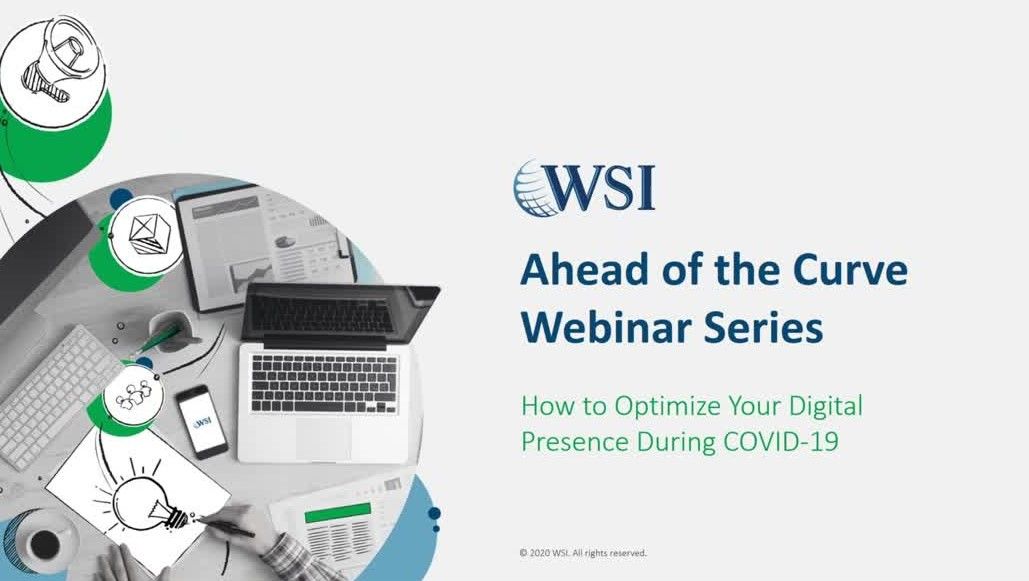7 Strategies for Optimizing Your Digital Presence During COVID-19

Summary: A quick recap, plus our Ahead of the Curve webinar on How to Optimize Your Digital Presence During COVID-19.
Due to popular demand, our digital marketing educational webinar series, Ahead of the Curve, has been extended until the end of May. We also hosted our 7th webinar and covered the topic of search engine optimization (SEO), and specifically How to Optimize Your Digital Presence During COVID-19.
During this session, WSI Digital Marketing Consultant, Mark Jaimeson, based out of Ottawa, Canada, shared his seven SEO recommendations and strategies for thriving in this new “normal”.
We’ve included a quick recap of Mark’s seven tips below.
1. Monitor Consumer Patterns, Behaviors & Channel Preferences
You must be monitoring consumer conversations right now. You should develop a clear understanding of how their habits are evolving, how their interactions with your brand are shifting, and where your brand can meet them to change these needs.
So, as lock-down protocols ease up and you can reopen your storefronts and allow customers to come back in, keep a close ear to the ground. Listen to what they’re saying. Understand their needs. Part of doing this may mean that you have to enable these conversations online (on your website via a chatbot, on your social channels, or via a customer feedback survey).
2. Strive for Expertise, Authoritativeness, & Trust (E.A.T)
You can nurture your brand by building your expertise, authority, and trust, or what Google refers to as the E.A.T Principle.
Google doesn’t want to serve up results to searches that take them to pages that are uneducated, that are opinion based or potentially fraudulent, or that actually can harm somebody.
So, what Google is asking business owners to do, especially now because of the high demand for traffic on the Internet, is:
- Demonstrate your expertise (this begins with proper keyword research)
- Show some authority (having backlinks from high authority sites)
- Showcase you are trustworthy (positive user reviews, and ensuring your site is secure)
If you concentrate on these three things, you will have a better chance of improving your website’s optimization.
3. Manage Your Web Presence’s Media: Owned, Earned & Paid
When it comes to having a strong SEO strategy, one that can help you drive more traffic to your
website, you need to be managing and controlling your brand narrative on all of your marketing channels. There are three types of marketing channels:
- Owned (website, social profiles, blog)
- Paid (third party channels, display ads, PPC)
- Earned (shared content, word-of-mouth reviews)
By taking stock of your media right now, you can ensure that you are speaking the right message, that your message is hitting people at the right time in the buying process, and that you’re monitoring what is being said about your brand online.
4. Audit Your Upcoming Content & Campaigns
If you had crafted any campaigns (PPC, content, social, etc.) before COVID, it’s good to reevaluate the messaging and topics you are using before you keep developing content or launch anything. Buying patterns and trends are changing. Digital marketing is still one of your best choices to reach your audience, but messaging that may have worked in the first quarter of the year, definitely won’t work now or even in the upcoming months. We highly recommend you take a look at your campaigns and audit them. Make sure they have pivoted and are aligned to the new normal.
5. Take Stock of Keywords You Are Currently Targeting
You also need to take stock of the keywords you’re currently targeting. Your products and services, and the way you deliver them possibly have changed. Which means, some of the search terms that people are searching for to find your products and services could have changed as well.
What’s essential for marketers to understand as well is that some of the keywords that you should be going after right now may not yet exist in Google’s database. Even if they do, they may have small search volumes associated with them. Search terms like “virtual showrooms for X vertical” could be keywords that start trending. Today, they may have little to no search volume, but 6-8 months from now, it could be a different story.
When it comes to keywords being used today, we need to be putting ourselves into the consumers’ minds and start foreseeing new search terms and going after them today.
6. Ensure Your Mobile Presence is Exceptional
Today’s consumer wants a seamless and fast mobile experience. Knowing this, on July 1, 2019, Google moved to a mobile-first indexing strategy. This means that Google indexes the mobile version of your website to determine your search engine ranking. So if you’re not providing an excellent mobile experience to your website visitors, you aren’t going to rank well from an SEO perspective.
We recommend that you take a look at your mobile site experience from your customers’ perspective. Go on your phone, and navigate through your mobile site and make sure it’s exceptional.
7. Focus on User Experience – it’s Everything!
When it comes to user experience online, we often talk about a website’s navigation, clear calls-to-actions, or accessible forms that can help improve conversions. Although this is all still applicable today, we need to consider the current state of affairs and consider a different type of user experience.
We recommend that you narrow your focus and think about what your customers need right now and speak directly to those needs front and center on your website. Move from the hard sell to the soft sell, and focus less on the products and services you’re offering and focus more on what you can do for your customers today. Make your customer service easily accessible. Ensure that your phone numbers, email addresses, new hours of operations, or instructions for pick-up and delivery are easy to find on your website.
For more details on the above strategies, watch the recording from our webinar, How to Optimize Your Digital Presence During COVID-19. We encourage you to check out our Ahead of the Curve recordings and upcoming sessions.

WSI was founded in 1995 and is an innovative digital marketing agency with offices in over 80 countries. We’ve spent over 20 years helping more than 100,000 companies and large global brands unlock the full potential of their business by leveraging the Internet and its many unrecognized opportunities. We’d be happy to help do the same for you and consult on your digital marketing strategy. Simply give me a call or email me at rknutsen@wsiebizsolutions.net to learn more.
About the Author
Rick spent 20 years in the insurance industry in finance, primarily developing reporting platforms for B & C stakeholders. His ability to speak to consumers of data (managers and analysts) and translate their needs to programmers led him to start his own digital marketing agency in 2004 to develop data driven solutions for business owners.
The Best Digital Marketing Insight and Advice
We are committed to protecting your privacy. For more info, please review our Privacy and Cookie Policies. You may unsubscribe at any time.
Don’t stop the learning now!


